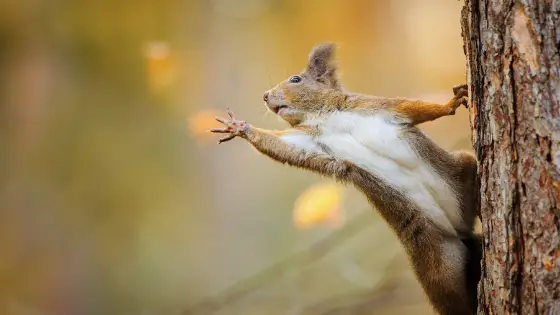Are you looking for a song to use with your younger grades and fun lessons to go with it?
Do you want to learn more about the song, Let Us Chase the Squirrel, and how to use it in your music room?
I learned this song early on in my pre-teacher training, and it’s been a popular staple in my classroom ever since. But I’m often asked by teacher friends for a Let Us Chase the Squirrel lessons plan, so I finally caved in to put out these resources.
A lesson plan for Let Us Chase the Squirrel may involve the chase game, rhythms focusing on half note, pitches do re mi sol, and accompanying with various instruments.
Read ahead for details and examples of activities to teach with this song.

Save time with these 60 FREE Music Resources to use in your room right away!
Stop searching the whole internet to find good activities. I’ll help you cut to the chase with my favorite 60 FREE resources.
Table of Contents
Let Us Chase The Squirrel Notation And Breakdown
Here is the notation for the song Let Us Chase the Squirrel. Look ahead for an analysis of the song.
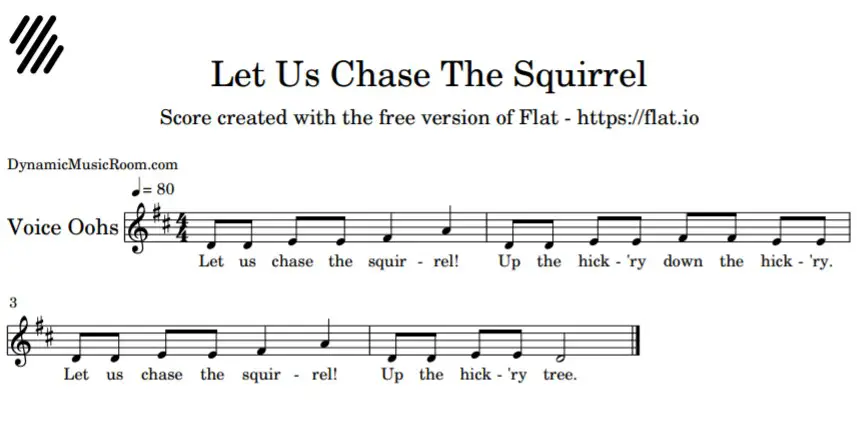
Grade Levels: PreK-1 for song and game, 2nd grade for notational elements
Pitches Used: do, re, mi, sol
Rhythms Used: half note, eighth notes, quarter note
History: John Philip Schinhan, Frank C. Brown Collection of North Carolina Folklore, Vol. V, 1962
Source: American Folk Song Collection
Suggested Melodic Elements For Teaching: Re
Suggested Rhythmic Elements For Teaching: Half note
5 Let Us Chase The Squirrel Lesson Plans
In this section, I’ll offer 4 lessons I use with this song including the activity.
The game and song can be used even as a squirrel song for preschoolers, but the notation and part-work may be left until late first grade or, better yet, second grade.
Teaching The Song
This is the method I use when teaching the song and activity. Words in italics are the things I say.
This is but one method of going about this, so if you feel more comfortable teaching the song in your own way, please do so!
Introducing Song:
One day I was out walking my dog in the forest when he saw a squirrel. Well, you can guess what he did then.
He chased the squirrel up a nearby hickory tree. After a while, he gave up, and the squirrel came down.
Then, my dog went after it again. Right up the tree the squirrel went!
Up and down and up and down they went.
Begin patting laps gently to the beat and sing the song.
The next day I went out with my dog again, and again he saw that stinky squirrel.
But this time, the squirrel climbed up a birch tree.
Sing the song and pat laps replacing “hick’ry” with “birch.”
What other trees could we use with this song?
Repeat singing with other types of trees from the students. Sing this way at least 5 more times.
Ask students to try to sing the song without you.
If they can, you’re ready to teach them the game.
If they can’t, you need to come back another and practice again.
Teaching The Chase Game
Every please stand in your circle and reach your arms way up high. You are now all hickory trees.
But now, I need a dog.
Select a dog student.
Now, who would like to be the squirrel?
Select a squirrel student.
The dog goes in the middle of the circle and the squirrel goes on the outside.
When we sing the song, it’s the dog’s job to chase the squirrel and try to tag them. The squirrel can go in and out of the trees to try to get away.
If the squirrel survives until the end of the song, they win. If the dog tags the squirrel, they win.
Play the game.
Now you both pick someone to take your job and you turn into a tree.
Repeat until all have had a turn.
Pro-tip: Take care to set up procedures for playing chase games in your space. I often tell kids they can’t run as hard as they can in here, but if they played outside at recess they could run as hard as they could.
This encourages them to take their music outside of your room too!
Teaching The Squirrel And Trees Game
Here is another way to play the game.
The class is split into three groups:
- 1 dog
- Half of the class as trees
- Half of the class as squirrels
The trees are spread out around the room and don’t move.
The squirrels roam around the room while everyone sings the song.
At the end of the song, the squirrels must curl up under a tree to be safe. The dog chases the squirrels, and anyone he or she tags becomes a dog for the next round.
Repeat 3-5 times then have the squirrels and trees switch jobs.
Reinforcing Half Note
With such great and exposed half notes at the end of each phrase, you’ll find it easy to reinforce half note with this song.
There are many ways you may want to do to teach half notes, but here are a few of my favorite lessons you can use if you’d like.
Kinesthetic
Sing the song and play the game. Follow up by having students echo clap the rhythms of the song using rhythm syllables.
When you get to the end with the half note, use the replacement syllable “slide” or just your favorite rhythm syllable.
Invite students to stand up and move their feet to the rhythms you pick.
For example, quarter notes are regular steps, eighth notes are quick tip-toes, and half notes are a slide.
For example, I’ll say the rhythm, “ta ta too.” The students say and move this rhythm repeating until they hear a sound cue such as a bell.
Visual
A quick way to introduce reading half notes is to use icons or pictures which represent the half note matching the rhythm values.
Here are the steps I use. Download the whole file free at the button below:
- Ask students to say rhythms matching the pictures with “running” for the squirrels and “dog” for the dog.
- When they get to the tree, ask them how many beats they think it’s worth. (Answer: 2).
- Now, say the rhythms with the stretched out word “tree” for half note.
- Next, the pictures are replaced with actual notation gradually as they say their real rhythm names. This depends on your preferred system.
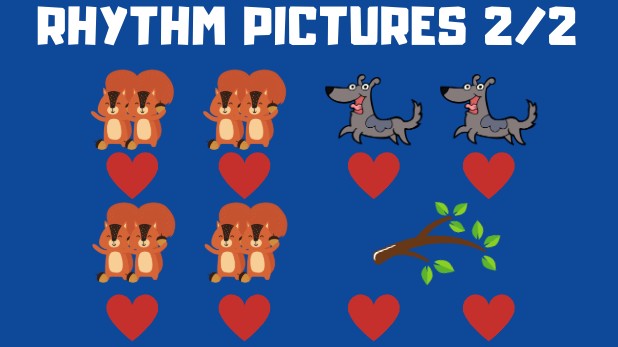
Create
Students should be engaged in creative activities with half notes early on as well. From the same file, ask students to create new rhythms as a class with pictures.
For small group or individual work, use a smart board or print off the pictures from the file.
For more information on teaching notes, look for information and details at the link.
Practicing “Re”
Similar to half note, this song may also be perfect for introducing “re”. Or if you’re following a Conversational Solfege sequence you may wish to use this for introducing “sol.”
Here are a few lessons I use with this song and re or sol.
Kinesthetic
Students use their hands to echo my singing and motions as I follow the melodic contour of the song.
Eventually, I switch to body solfege motions:
- Do = hands on hips
- Re = hands crossed over body
- Mi = Touching shoulders
- Sol = Touching head
After some more copying, I ask students to create their own motions.
Visual
Students read the pitches from pictures of acorns on a staff. Ask them about the new note (re or sol depending on your sequence) and where it exists in relation to the notes they know.
Is it higher or lower than do? Mi?
How much higher or lower is it? A step? A skip?
I switch to the color coordinated acorns and assign students in smaller groups to a specific pitch. They have to sing only their pitch.
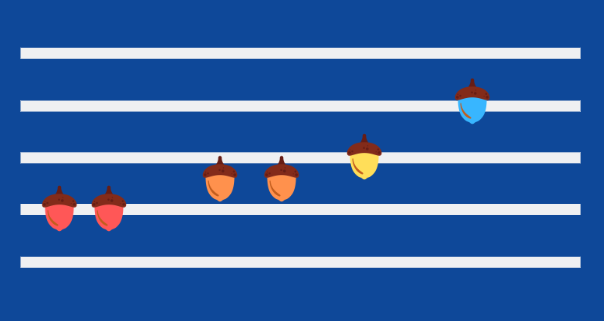
Create
Students read each of the pitches in the four beat card on solfege in their small group of three or four.
First, they need to try to arrange the cards, so it matches the original song.
Then, they can move the cards around to create their own original songs using the cards.
If you wanted to extend the activity further, they can create their own lyrics as well.
Note: Click the button above for the complete file totally FREE.
Harmony And Part Work
As an almost perfect pentatonic song, this song fits well with many simple layered parts and harmonies.
Here are a few part work activities you may want to add in your classroom.
Layered Ostinati
With such interesting rhythm and melody, it’s simple to add some layered ostinati to the song and create an interesting piece.
Pro-tip: Have students sing the song while you perform an ostinato. Then, switch.
Don’t go for splitting the class up right away unless they’ve had a lot of part-work practice.
Note: These ostinati may be performed as rhythmic or melodic patterns.
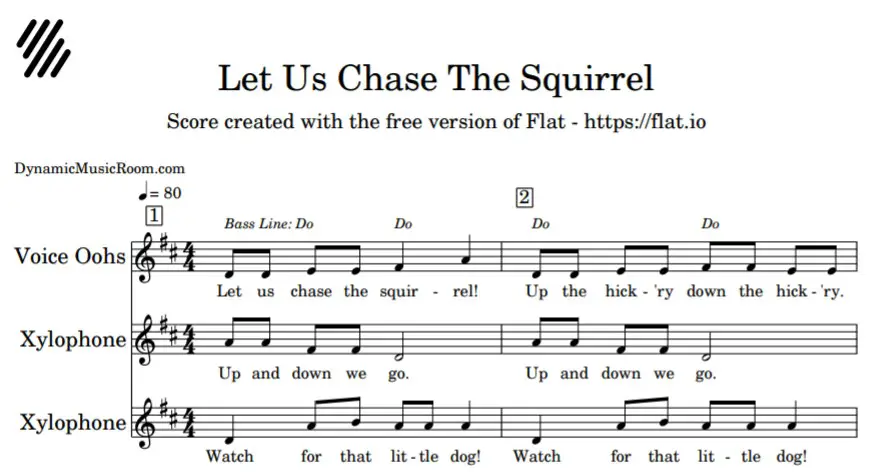
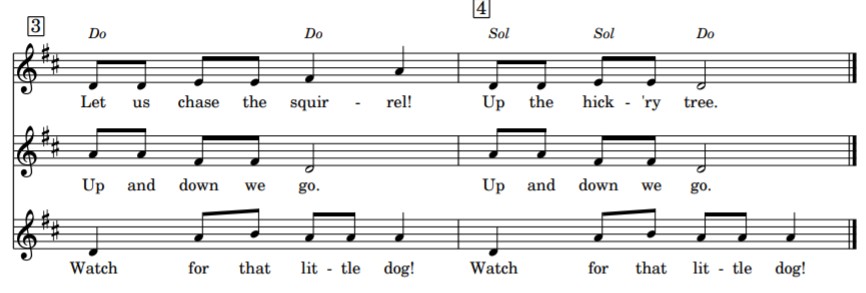
Canon
As an almost-pentatonic song, you can perform this in a sort of canon. Look at the numbers in the notation above for when the different groups enter.
Pro-tip: Move students away from each other and into their own circle depending on the group to encourage independent work. Don’t let them plug their ears.
Bass Line
It’s also possible to use a bass line as an accompaniment to this song.
First, students should sing the bass line part, and then you may let them play on contrabass bars, boomwhackers, or hand bells.
(I love these hand bells by Rhythm Band. They’re durable and have a button to push instead of swinging them about.)
Bass line notes use do and sol and are indicated in the notation above the measures.
Conclusion
I hope you find these Let Us Chase the Squirrel lesson plans helpful. I use this song a lot in my classroom and pull as much out of this song as I can.

Save time with these 60 FREE Music Resources to use in your room right away!
Stop searching the whole internet to find good activities. I’ll help you cut to the chase with my favorite 60 FREE resources.

